Abstract
The effect of hypothermia on neutrophil circulation and release from bone marrow has been studied. Pigs were anesthetized and maintained at 37 degrees C or surface cooled to 29 degrees C over 60 min. As the core temperature was reduced to 29 degrees C, the number of circulating neutrophils (X 10(9) per liter) fell from 6.0 +/- 0.6 to 2.3 +/- 0.3 by 60 min. No significant change in the number of circulating mature or immature neutrophils was observed over the 4 h of observation at 29 degrees C. Neutrophil demargination after administration of intravenous catecholamines was similar at 37 and 29 degrees C. Steroid stimulation of bone marrow to release neutrophils was markedly impaired at 29 degrees C. Circulating mature neutrophils in normothermic pigs increased from 5.6 +/- 1.2 to 10.4 +/- 1.2 by 120 min after administration of intravenous hydrocortisone sodium succinate. Circulating immature neutrophils increased from 1.7 +/- 0.3 to 5.3 +/- 0.4. At 29 degrees C, no significant changes in the number of circulating mature or immature neutrophils occurred. Endotoxin also failed to stimulate neutrophil release from the bone marrow. Furthermore, a marked neutropenia occurred in hypothermic pigs after intravenous endotoxin, which persisted for the 3 h of observation. Neutrophil circulation and release from bone marrow are compromised by hypothermia, which may increase the risk for bacterial infection.
Full text
PDF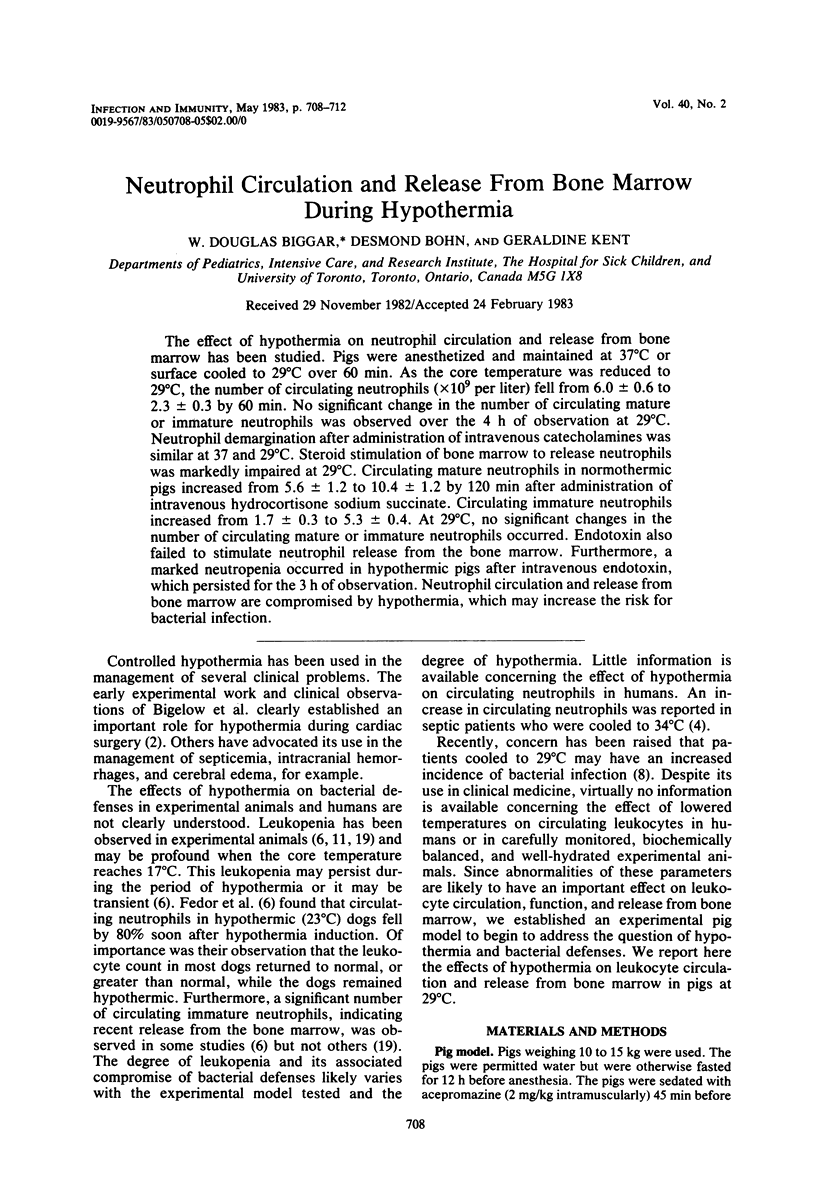
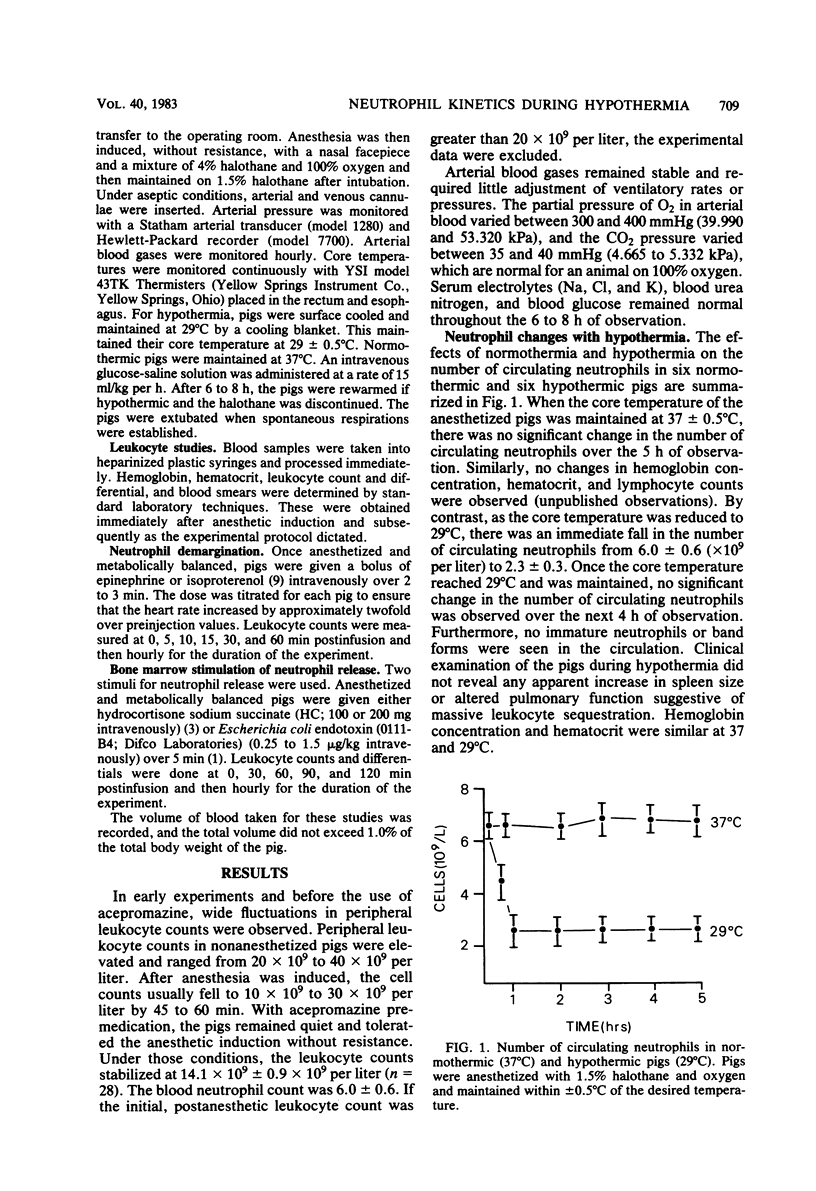
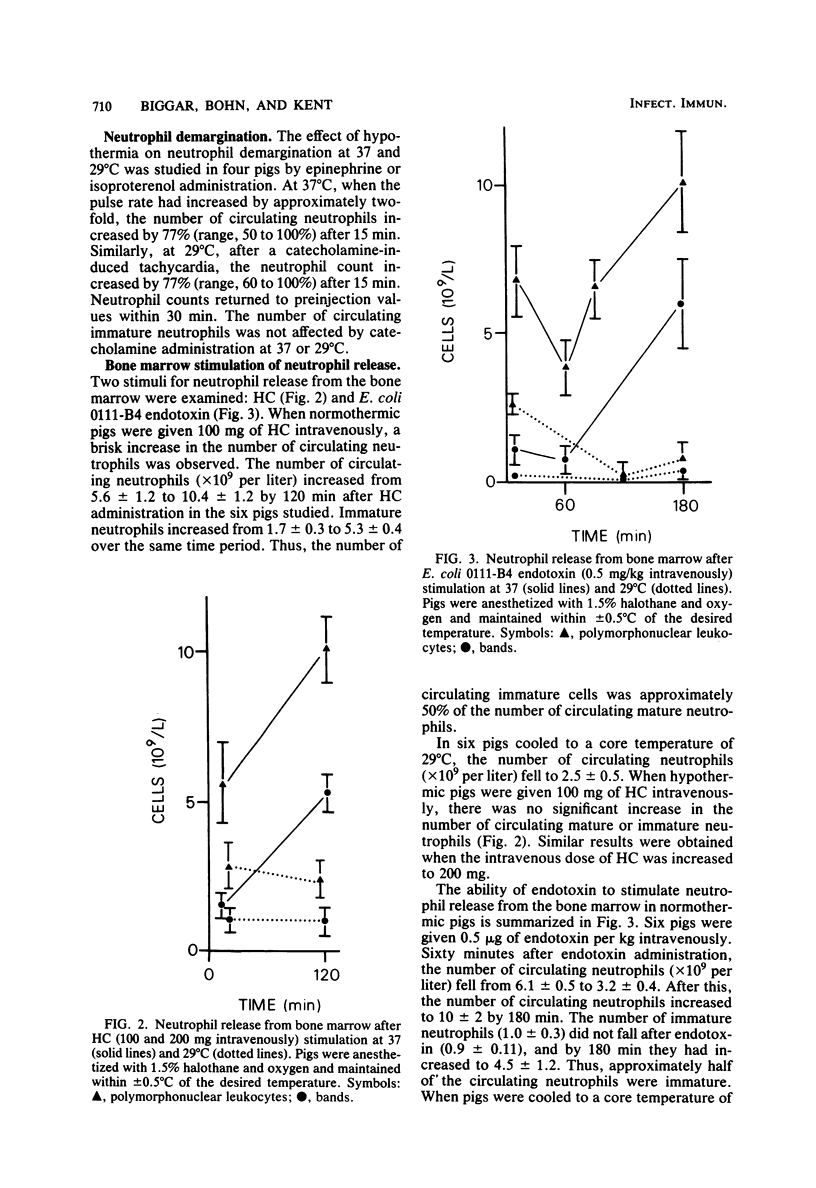
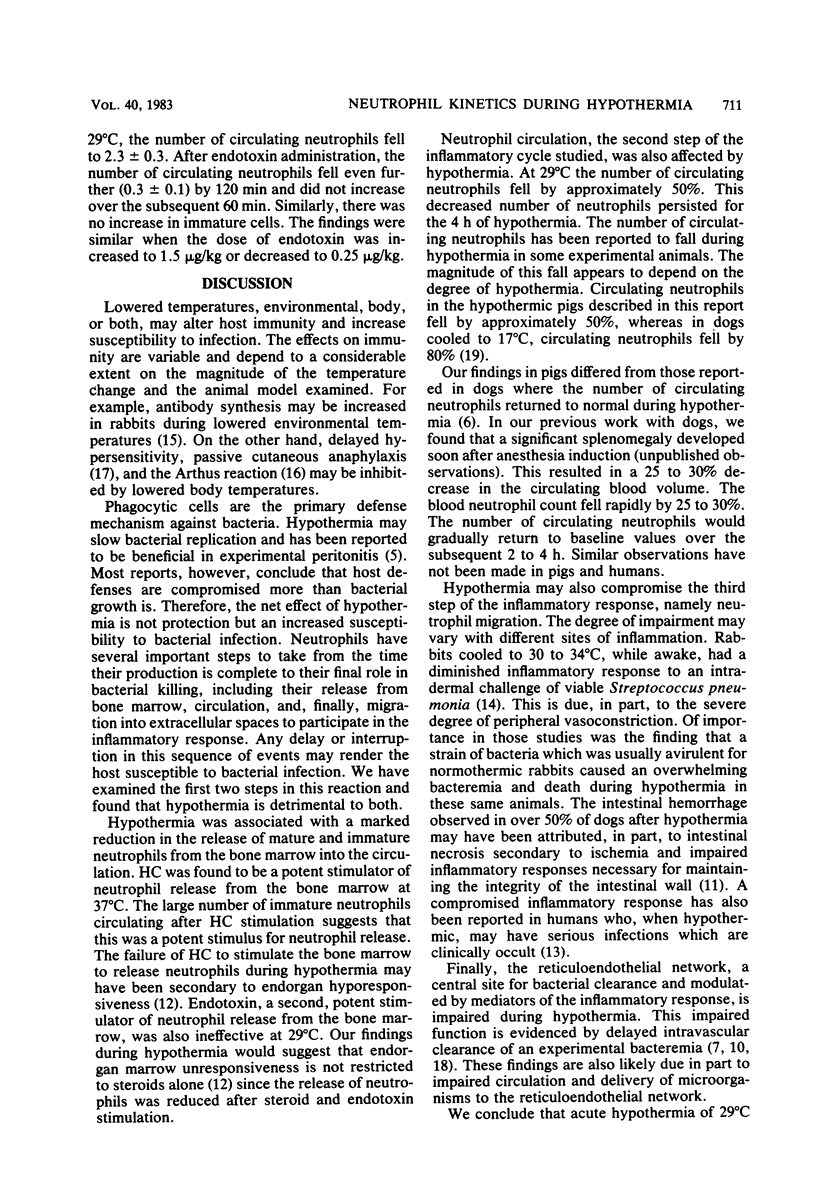
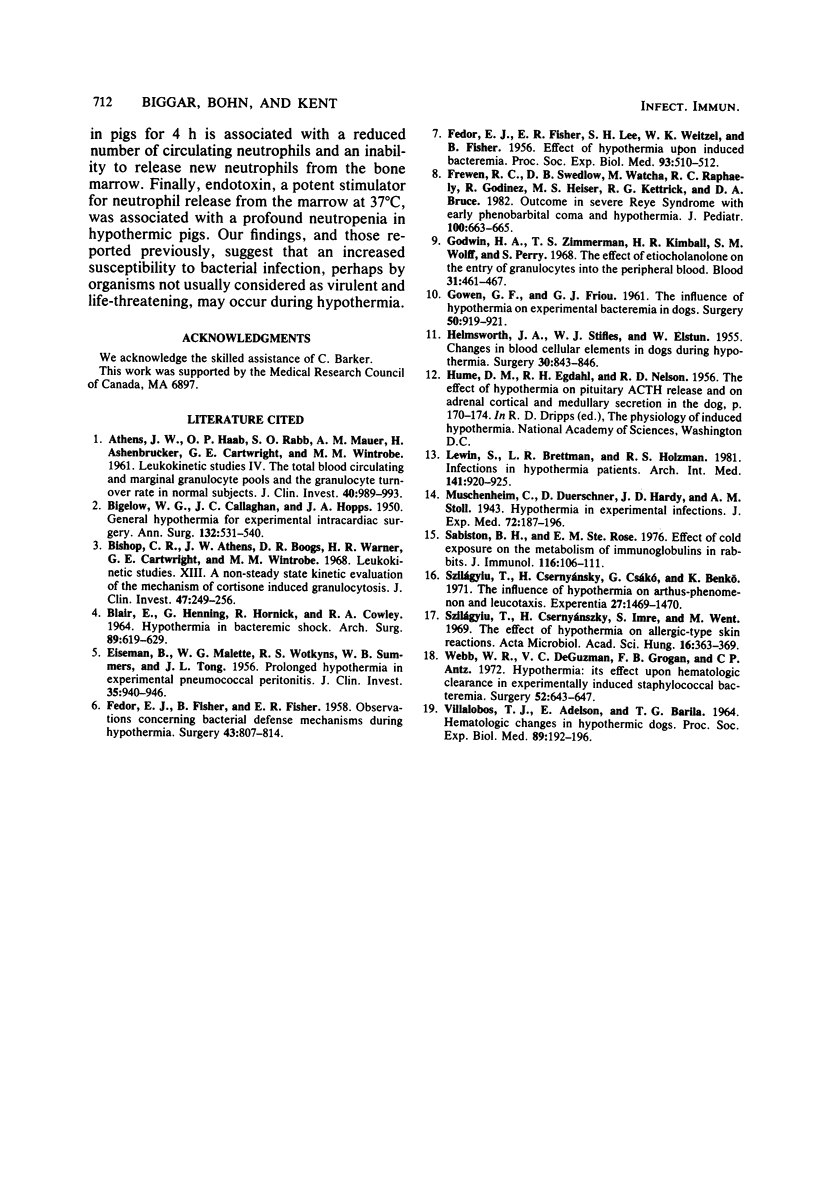
Selected References
These references are in PubMed. This may not be the complete list of references from this article.
- ATHENS J. W., HAAB O. P., RAAB S. O., MAUER A. M., ASHENBRUCKER H., CARTWRIGHT G. E., WINTROBE M. M. Leukokinetic studies. IV. The total blood, circulating and marginal granulocyte pools and the granulocyte turnover rate in normal subjects. J Clin Invest. 1961 Jun;40:989–995. doi: 10.1172/JCI104338. [DOI] [PMC free article] [PubMed] [Google Scholar]
- BIGELOW W. G., CALLAGHAN J. C., HOPPS J. A. General hypothermia for experimental intracardiac surgery; the use of electrophrenic respirations, an artificial pacemaker for cardiac standstill and radio-frequency rewarming in general hypothermia. Ann Surg. 1950 Sep;132(3):531–539. doi: 10.1097/00000658-195009000-00018. [DOI] [PMC free article] [PubMed] [Google Scholar]
- BLAIR E., HENNING G., HORNICK R., COWLEY R. A. HYPOTHERMIA IN BACTEREMIC SHOCK. Arch Surg. 1964 Oct;89:619–629. doi: 10.1001/archsurg.1964.01320040035006. [DOI] [PubMed] [Google Scholar]
- Bishop C. R., Athens J. W., Boggs D. R., Warner H. R., Cartwright G. E., Wintrobe M. M. Leukokinetic studies. 13. A non-steady-state kinetic evaluation of the mechanism of cortisone-induced granulocytosis. J Clin Invest. 1968 Feb;47(2):249–260. doi: 10.1172/JCI105721. [DOI] [PMC free article] [PubMed] [Google Scholar]
- EISEMAN B., MALETTE W. G., SUMMERS W. B., TONG J. L., WOTKYNS R. S. Prolonged hypothermia in experimental pneumococcal peritonitis. J Clin Invest. 1956 Sep;35(9):940–946. doi: 10.1172/JCI103353. [DOI] [PMC free article] [PubMed] [Google Scholar]
- FEDOR E. J., FISHER B., FISHER E. R., LEE S. H., WEITZEL W. K. Effect of hypothermia upon induced bacteremia. Proc Soc Exp Biol Med. 1956 Dec;93(3):510–512. doi: 10.3181/00379727-93-22801. [DOI] [PubMed] [Google Scholar]
- FEDOR E. J., FISHER B., FISHER E. R. Observations concerning bacterial defense mechanisms during hypothermia. Surgery. 1958 May;43(5):807–814. [PubMed] [Google Scholar]
- Frewen T. C., Swedlow D. B., Watcha M., Raphaely R. C., Godinez R. I., Heiser M. S., Kettrick R. G., Bruce D. A. Outcome in severe Reye syndrome with early pentobarbital coma and hypothermia. J Pediatr. 1982 Apr;100(4):663–665. doi: 10.1016/s0022-3476(82)80782-8. [DOI] [PubMed] [Google Scholar]
- GOWEN G. F., FRIOU G. J. The influence of hypothermia on experimental bacteremia in dogs. Surgery. 1961 Dec;50:919–921. [PubMed] [Google Scholar]
- Godwin H. A., Zimmerman T. S., Kimball H. R., Wolff S. M., Perry S. The effect of etiocholanolone on the entry of granulocytes into the peripheral blood. Blood. 1968 Apr;31(4):461–470. [PubMed] [Google Scholar]
- HELMSWORTH J. A., STILES W. J., ELSTUN W. Changes in blood cellular elements in dogs during hypothermia. Surgery. 1955 Nov;38(5):843–846. [PubMed] [Google Scholar]
- Lewin S., Brettman L. R., Holzman R. S. Infections in hypothermic patients. Arch Intern Med. 1981 Jun;141(7):920–925. [PubMed] [Google Scholar]
- Sabiston B. H., Rose J. E. Effect of cold exposure on the metabolism of immunoglobulins in rabbits. J Immunol. 1976 Jan;116(1):106–111. [PubMed] [Google Scholar]
- Szilágyi T., Csernyánszky H., Imre S., Went M. The effect of hypothermia on allergic-type skin reactions. Acta Microbiol Acad Sci Hung. 1969;16(4):363–369. [PubMed] [Google Scholar]
- VILLALOBOS T. J., ADELSON E., BARILA T. G. Hematologic changes in hypothermic dogs. Proc Soc Exp Biol Med. 1955 Jun;89(2):192–196. doi: 10.3181/00379727-89-21754. [DOI] [PubMed] [Google Scholar]
- WEBB W. R., DEGUZMAN V. C., GROGAN J. B., ARTZ C. P. Hypothermia: its effects upon hematologic clearance in experimentally induced staphylococcal bacteremia. Surgery. 1962 Oct;52:643–647. [PubMed] [Google Scholar]


